The Henry Ford
The Henry Ford (also known as the Henry Ford Museum of American Innovation and Greenfield Village, and as the Edison Institute) is a history museum complex in the Detroit suburb of Dearborn, Michigan, United States.[3][4] The museum collection contains the presidential limousine of John F. Kennedy, Abraham Lincoln's chair from Ford's Theatre, Thomas Edison's laboratory, the Wright Brothers' bicycle shop, the Rosa Parks bus, and many other historical exhibits. It is the largest indoor–outdoor museum complex in the United States[5] and is visited by over 1.7 million people each year.[6] It was listed on the National Register of Historic Places in 1969 as Greenfield Village and Henry Ford Museum[1] and designated a National Historic Landmark in 1981 as "Edison Institute".[2]
Edison Institute Greenfield Village and Henry Ford Museum | |
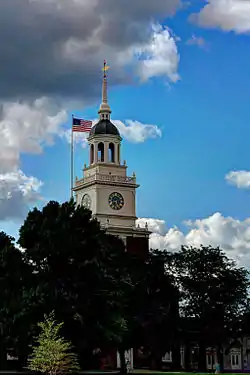 The museum clock tower. The building is a replica of Independence Hall in Philadelphia. | |
  | |
| Location | The Henry Ford 20900 Oakwood Boulevard at Village Road Dearborn, Michigan United States |
|---|---|
| Coordinates | 42°18′13″N 83°14′03″W |
| Built | 1929 |
| Architect | Robert O. Derrick |
| Visitation | 1.7 million |
| NRHP reference No. | 69000071 |
| Significant dates | |
| Added to NRHP | October 20, 1969[1] |
| Designated NHLD | December 21, 1981[2] |
Museum background
Named for its founder, the automobile industrialist Henry Ford, and based on his efforts to preserve items of historical interest and portray the Industrial Revolution, the property houses homes, machinery, exhibits, and Americana of historically significant items as well as common memorabilia, both of which help to capture the history of life in early America. It is one of the largest such collections in the nation.[7]
Henry Ford said of his museum:
I am collecting the history of our people as written into things their hands made and used .... When we are through, we shall have reproduced American life as lived, and that, I think, is the best way of preserving at least a part of our history and tradition ...[8]
History
Architect Robert O. Derrick designed the museum with a 523,000 square feet (48,600 m2) exhibit hall that extends 400 feet (120 m) behind the main façade. The façade spans 800 feet (240 m) and incorporates facsimiles of three structures from Independence National Historical Park in Philadelphia – Old City Hall, Independence Hall and Congress Hall.[9][10]
The Edison Institute was dedicated by President Herbert Hoover to Ford's longtime friend Thomas Edison on October 21, 1929 – the 50th anniversary of the first successful incandescent light bulb. The attendees included Marie Curie, George Eastman, John D. Rockefeller, Will Rogers, Orville Wright, and about 250 others.[11] The dedication was broadcast on radio with listeners encouraged to turn off their electric lights until the switch was flipped at the Museum.[12]
The Edison Institute was, at first, a private site for educational purposes only, but after numerous inquiries about the complex, it was opened as a museum to the general public on June 22, 1933.[13] It was originally composed of the Henry Ford Museum, Greenfield Village, and the Greenfield Village Schools (an experimental learning facility). Initially, Greenfield Village and the Henry Ford Museum were owned by the Ford Motor Company, which is currently a sponsor of the school and cooperates with the Henry Ford to provide the Ford Rouge Factory Tour. The Henry Ford is sited between the Ford Dearborn Development Center and several Ford engineering buildings with which it shares the same style gates and brick fences.
In 1970, the museum purchased what it believed to be a 17th-century Brewster Chair, created for one of the Pilgrim settlers in the Plymouth Colony, for $9,000. In September 1977, the chair was determined to be a modern forgery created in 1969 by Rhode Island sculptor Armand LaMontagne.[14] The museum retains the piece as an educational tool on forgeries.[15]
In the early 2000s, the museum added an auditorium to the building's south corner. This housed an IMAX theater until January 2016 when museum management decided to change formats for the facility to better fit with its mission. The renovated theater reopened in April of that year.[16]
Henry Ford Museum of American Innovation

The Henry Ford Museum of American Innovation began as Henry Ford's personal collection of historic objects, which he began collecting as far back as 1906. Today, the 12 acre (49,000 m2) site is primarily a collection of antique machinery, pop culture items, automobiles, locomotives, aircraft, and other items:
- The museum features a 4K digital projection theater,[16] which shows scientific, natural, or historical documentaries, as well as major feature films.
- An Oscar Mayer Wienermobile[17]
- The 1961 Lincoln Continental, SS-100-X in which President John F. Kennedy was riding when he was assassinated.[18]
- The rocking chair from Ford's Theatre in which President Abraham Lincoln was sitting when he was shot by John Wilkes Booth.[17]
- George Washington's camp bed.[17]
- A collection of several fine 17th- and 18th-century violins including a Stradivarius.[19]
- Thomas Edison's alleged last breath in a sealed tube.
- Buckminster Fuller's prototype Dymaxion house.[20]
- The bus on which Rosa Parks was arrested for refusing to give up her seat, leading to the Montgomery bus boycott.[21][22]
- Igor Sikorsky's prototype helicopter.
- Fokker Trimotor airplane that flew the first flight over the North Pole.[23]
- Bill Elliott's record-breaking race car clocking in at over 212 MPH at Talladega in 1987[24]
- Fairbottom Bobs, the Newcomen engine
- A steam engine from Cobb's Engine House in England.[25]
- A working fragment of the original Holiday Inn "Great Sign"
- Chesapeake & Ohio Railway 2-6-6-6 "Allegheny"-class steam locomotive #1601, built by Lima Locomotive Works in Lima, Ohio. The Allegheny was the third most-powerful steam locomotive ever built, after the Union Pacific Railroad "Big Boy" 4-8-8-4 locomotive and the Pennsylvania Railroad Q2-class 4-4-6-4 locomotive.[26]
- Toyota Prius sedan, the first mass-produced hybrid vehicle.[27]
Behind the scenes, the Benson Ford Research Center uses the resources of The Henry Ford, especially the photographic, manuscript and archival material which is rarely displayed, to allow visitors to gain a deeper understanding of American people, places, events, and things. The Research Center also contains the Ford Motor Archives.[28]
To commemorate the 100th anniversary of the sinking of the RMS Titanic, the Henry Ford Museum exhibited a vast array of artifacts and media documenting the Titanic's voyage and demise. The exhibit was hosted from 31 March to 30 September 2012.
Selected exhibits
- Airplanes
 1903 Wright Flyer replica
1903 Wright Flyer replica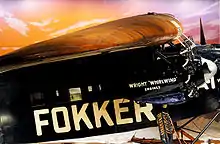
 Byrd Arctic Expedition exhibit
Byrd Arctic Expedition exhibit A 1939 Northwest Airlines Douglas DC-3
A 1939 Northwest Airlines Douglas DC-3
- Agriculture
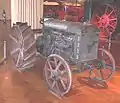
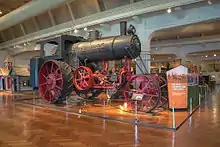 Steam Tractor Engine
Steam Tractor Engine
- Automobiles
 The 1896 Ford Quadricycle
The 1896 Ford Quadricycle An 1899 Duryea
An 1899 Duryea 1908 Stevens-Duryea Model U limo (brown) and 1915 Chevrolet Royal Mail Roadster (green)
1908 Stevens-Duryea Model U limo (brown) and 1915 Chevrolet Royal Mail Roadster (green) A 1916 Apperson Touring Car
A 1916 Apperson Touring Car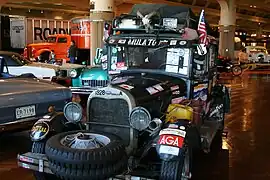 1928 Model A Ford
1928 Model A Ford

 1950s era Oscar Mayer Wienermobile
1950s era Oscar Mayer Wienermobile The first production built Ford Mustang
The first production built Ford Mustang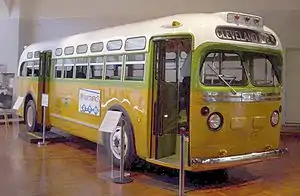 The bus on which Rosa Parks was arrested, an event which started the Montgomery bus boycott
The bus on which Rosa Parks was arrested, an event which started the Montgomery bus boycott Interior of the "Rosa Parks" bus
Interior of the "Rosa Parks" bus 1927 Blue Bird school bus
1927 Blue Bird school bus
- Presidential limousines
| External video | |
|---|---|
 The Sunshine Special, the official state car used by US President Franklin D. Roosevelt
The Sunshine Special, the official state car used by US President Franklin D. Roosevelt The SS-100-X used by John F. Kennedy
The SS-100-X used by John F. Kennedy
- Made In America
| External video | |
|---|---|
 Watt Canal Pumping Engine (1796)
Watt Canal Pumping Engine (1796) Watt Rotative Engine
Watt Rotative Engine Thomas Horn Engine (1850)
Thomas Horn Engine (1850) Stationary Steam Engine (1850)
Stationary Steam Engine (1850) Water Engine and Electric Generator, Spokane, Washington (1903)
Water Engine and Electric Generator, Spokane, Washington (1903)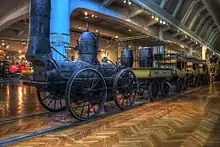 1831 DeWitt Clinton train replica
1831 DeWitt Clinton train replica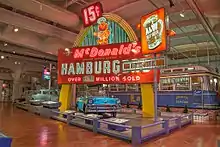
 Chesapeake and Ohio Railway locomotive C&O 1601
Chesapeake and Ohio Railway locomotive C&O 1601
Greenfield Village
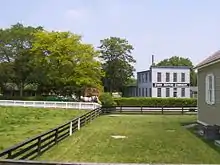
Greenfield Village, the outdoor living history museum section of the Henry Ford complex, was (along with the adjacent Henry Ford Museum) dedicated in 1929 and opened to the public in June 1933.[29] It was the first outdoor museum of its type in the nation, and served as a model for subsequent outdoor museums.[7] Patrons enter at the gate, passing by the Josephine Ford Memorial Fountain and Benson Ford Research Center. Nearly one hundred historical buildings were moved to the property from their original locations and arranged in a "village" setting. The museum's intent is to show how Americans have lived and worked since the founding of the country. The Village includes buildings from the 17th century to the present, many of which are staffed by costumed interpreters who conduct period tasks such as farming, sewing and cooking. A collection of craft buildings such as pottery, glass-blowing, and tin shops provide demonstrations while producing materials used in the Village and for sale. The Village features costumed and plain-clothed presenters to tell stories and convey information about the attractions. Some of these presenters are seasonal, such as the "games on the green" presenters who only operate in the summer. Greenfield Village has 240 acres (970,000 m2) of land of which only 90 acres (360,000 m2) are used for the attraction, the rest being forest, river and extra pasture for the sheep and horses.
| External video | |
|---|---|
Village homes, buildings, and attractions include:
- Noah Webster's Connecticut home, which served as a dormitory for Yale students from 1918 to 1936, when it was obtained by Henry Ford and moved to Greenfield Village where it was restored.[30][31]
- The Wright brothers' bicycle shop and home, which were bought and moved by Henry Ford in 1937 from Dayton, Ohio.[32][33]
- A replica of Thomas Edison's Menlo Park laboratory complex from New Jersey. Its reconstruction started in 1928. The buildings were laid out according to exact foundation measurements from the original site. It was furnished with original or faithful duplicates, all placed as they were originally.[34][35][36]
- The Edison Homestead, birthplace of Thomas Edison's father. It was built in 1816 in Vienna, Ontario, and moved to Greenfield Village in the 1930s.[37]
- Henry Ford's birthplace, which was moved from Greenfield and Ford roads in 1944. Henry Ford had it furnished exactly as it was during his mother's time.[38][23]
- Henry Ford's prototype garage where he built the Ford Quadricycle.
- Harvey S. Firestone's family farmhouse from Columbiana, Ohio, which was given to the Village by Harvey's two remaining sons in 1983 to perpetuate their father's memory. The disassembling and rebuilding process took over two years, and the farm has been operated as a working sheep farm since 1985.[30][23]
- The Logan County, Illinois, courthouse where Abraham Lincoln practiced law.[39]
- William Holmes McGuffey's birthplace.[23]
- Luther Burbank's office.[40]
- J. R. Jones General Store was built circa 1857 in Waterford Village, Michigan. It was moved to Greenfield Village in 1927 after being purchased by Henry Ford from its then-owner August V. Jacober for $700 and the agreement to rebuild a new store on its Waterford site. It was the first structure to arrive at the Greenfield Village site. The general store was placed in its permanent location facing the village green in the spring of 1929.[41]
- Ackley Covered Bridge, a 75-foot wooden covered bridge, built in 1832 over Enlow Fork along the Greene–Washington County line in Southwestern Pennsylvania and moved to the village in 1937.[42]
- Cape Cod Windmill, also known as the Farris mill, is considered one of the oldest in America. It was originally built in 1633 on the north side of Cape Cod. It was moved several times around Cape Cod until it was given to Henry Ford by the Ford Dealers Association, and installed in Greenfield Village in 1936.[43]
- In 1935, a structure was added to the park and was identified as the home of Stephen Foster. The structure was identified by historians of the time as being authentic and was then deconstructed and moved "piece by piece" from the Lawrenceville neighborhood of Pittsburgh, Pennsylvania, to Greenfield Village, Michigan. Foster's niece insisted that it was not his birthplace, and in 1953 the claim was withdrawn.[44][45]
- A 1913 Herschell Spillman carousel with an Artizan 'C' band organ with a replica Wurlitzer #153 facade converted to play Wurlitzer rolls.
There are various modes of historic transportation in the Village providing rides for visitors, which utilize authentic Ford Model Ts, a 1931 Ford Model AA bus (one of about 15 known to exist), horse-drawn omnibuses, and trains pulled by steam locomotives.
Weiser Railroad
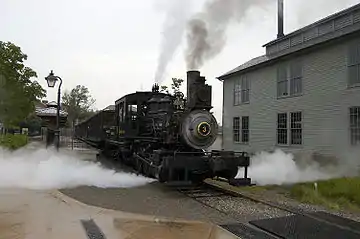 The Weiser Railroad's Torch Lake steam locomotive, built in 1873, is the oldest operational locomotive in the U.S. as of 2021.[46] | |
| Overview | |
|---|---|
| Headquarters | Dearborn, Michigan |
| Locale | Dearborn, Michigan, U.S. |
| Dates of operation | 1929–present |
| Technical | |
| Track gauge | 1,435 mm (4 ft 8+1⁄2 in) |
| Length | 2 miles (3.2 km) |
.jpg.webp)
Weiser Railroad | |||||||||||||||||||||||||||||||||||||||||||||||||||||||||||||||||||||||||||||||||||||||||||||||||||||||||||||||||||||||||||||||
|---|---|---|---|---|---|---|---|---|---|---|---|---|---|---|---|---|---|---|---|---|---|---|---|---|---|---|---|---|---|---|---|---|---|---|---|---|---|---|---|---|---|---|---|---|---|---|---|---|---|---|---|---|---|---|---|---|---|---|---|---|---|---|---|---|---|---|---|---|---|---|---|---|---|---|---|---|---|---|---|---|---|---|---|---|---|---|---|---|---|---|---|---|---|---|---|---|---|---|---|---|---|---|---|---|---|---|---|---|---|---|---|---|---|---|---|---|---|---|---|---|---|---|---|---|---|---|---|
| |||||||||||||||||||||||||||||||||||||||||||||||||||||||||||||||||||||||||||||||||||||||||||||||||||||||||||||||||||||||||||||||
The rail line on which the steam locomotives in Greenfield Village presently run originally consisted of a simple straight stretch of track along the northern edge of the museum property, and has been present ever since Greenfield Village was dedicated in 1929. The rail line, now named the Weiser Railroad, was later expanded into a continuous loop around the perimeter of the museum property, which was completed in stages between 1971 and 1972.[47] This 4 ft 8+1⁄2 in (1,435 mm) standard gauge passenger line is 2 miles (3.2 km) long and has four stations. All of the railroad's stations consist solely of single side platforms except for the station in the Railroad Junction section, which also includes the relocated Smiths Creek Depot building originally built for the Grand Trunk Railway in 1858.[48]
The line utilizes a modern replica of a Detroit, Toledo & Milwaukee Railroad (DT&M) roundhouse built in 1884.[49] At the time it was opened to the public in 2000, the new DT&M Roundhouse replica was one of only seven working roundhouses open to the public in the United States.[50]
The railroad, unusual for a heritage railroad built purposely for tourism, has a direct connection to the United States National Railroad Network. The line to which it connects is a section of the Michigan Line owned by MDOT[51] and is used by Amtrak's Wolverine service, which runs between Chicago, Illinois, and Pontiac, Michigan. In the past, Amtrak's Greenfield Village station provided direct access to Greenfield Village near the Weiser Railroad's Smiths Creek Depot for reserved tour groups of twenty or more. It was consolidated in December 2014 with the new John D. Dingell Transit Center. The new transit center is adjacent to the Henry Ford museum complex and has a gate allowing access to the complex via a short walk.[52]
| Number | Name | Wheel arrangement | Year built | Builder | Original road | Status | Notes |
|---|---|---|---|---|---|---|---|
| 3 | Torch Lake | 0-6-4T | 1873 | Mason Machine Works | Hecla & Torch Lake Railroad | Operational | Articulated. Only surviving Mason Bogie locomotive in the world. Oldest operational locomotive in the U.S. as of 2021. |
| 1 | Edison | 4-4-0 | 1875 | Manchester Locomotive Works | Edison Portland Cement Company | Operational | Originally an 0-4-0, which was rebuilt into a 4-4-0 by Ford in 1932. |
| 7 | 4-4-0 | 1897 | Baldwin Locomotive Works | Detroit & Lima Northern Railway | Operational | Henry Ford's personal locomotive. Donated by Henry Ford in 1930. Restored from 2007 to 2013. | |
| 45 | 4-4-2 | 1902 | ALCO | Michigan Central Railroad | Display | Cosmetically restored. On static display in the roundhouse. | |
| B | 1927 | Plymouth Locomotive Works | Mistersky Power Plant | Operational | Gasoline powered | ||
| 1 | B-B | 1942 | General Electric | United States Navy | Operational | 50-ton switcher | |
Greenfield Village gallery
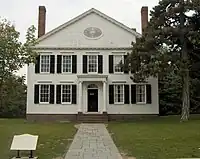 Noah Webster's home from New Haven, Connecticut
Noah Webster's home from New Haven, Connecticut A garden and the Ackley Covered Bridge
A garden and the Ackley Covered Bridge The Burbank cottage (left) and Garden House Shop
The Burbank cottage (left) and Garden House Shop A Ford Model T giving rides at The Henry Ford
A Ford Model T giving rides at The Henry Ford Charles Proteus Steinmetz owned this small cabin that overlooked the Mohawk River near Schenectady, New York.
Charles Proteus Steinmetz owned this small cabin that overlooked the Mohawk River near Schenectady, New York.
- Thomas Edison exhibits
 Upper level of Thomas Edison's Menlo Park Laboratory
Upper level of Thomas Edison's Menlo Park Laboratory Three crucibles in Thomas Edison's Menlo Park Laboratory. At the left is a boiler and a small steam engine.
Three crucibles in Thomas Edison's Menlo Park Laboratory. At the left is a boiler and a small steam engine.
- Wright Brothers exhibits
 Wilbur and Orville Wright's house and bicycle shop
Wilbur and Orville Wright's house and bicycle shop The Wright Brothers' house relocated from Dayton, Ohio
The Wright Brothers' house relocated from Dayton, Ohio The Wright Cycle Company building
The Wright Cycle Company building
Signature events
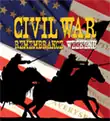
Civil War Remembrance
Each year the Village honors the sacrifices and achievements of those who fought in the American Civil War. The Civil War Remembrance event takes place Memorial Day weekend (Saturday–Monday) every year. An estimated 750,000 people died during the Civil War. The Civil War Remembrance is a weekend event, which includes hundreds of Union and Confederate reenactors, musicians and historic presenters. This event features more than 400 Civil War reenactors who spend the entire weekend in the Village. Greenfield Village provides many opportunities in order to learn about the Civil War: exhibits, presentations, battle reenactments, concerts, short plays, hands-on activities and Q&A with historians.[56]
Motor Muster
Motor Muster is one of two car shows that take place annually in Greenfield Village. Motor Muster is traditionally held on Father's Day weekend. This event currently features cars built from 1932 to 1976, and features between 600 and 800 cars. Special attractions include car judging, and Pass in Review in which experts discuss highlights of the passing cars.
Summer Camp
Every summer the Henry Ford has a Summer Camp. It takes place inside Greenfield Village and the Henry Ford Museum between June and August. It is for children in grades 2–9.[57] Each grade level has a different theme and children who participate in the Summer Camp have the opportunity to look at both the Henry Ford Museum of American Innovation and Greenfield Village from different perspectives. Children participate in activities such as: apprenticeships, canoeing, glass blowing and other age-dependent activities.
World Tournament of Historic Base Ball
The World Tournament of Historical Base Ball takes place every year in August. Guests get to take a step back in time to 1867 as vintage base ball clubs from around the country compete by the game's early rules in a two-day exposition of historic base ball.[58] The clubs engage in two days of throwing, batting and competition. The event is included in Greenfield Village admission.[59]
Salute to America
For four nights around Independence Day, the Detroit Symphony Orchestra performs a patriotic concert on Walnut Grove in the Village. Attendance ranges from 5000 to 9500 per evening.
Ragtime Street Fair
This weekend event in July was first presented in 2007 and ran annually through 2015. Ragtime Street Fair featured dozens of live performers, including the River Raisin Ragtime Revue, "Perfessor" Bill Edwards, Mike Montgomery, Nan Bostick, Taslimah Bey, John Remmers, and Tartarsauce Traditional Jazz Band, who celebrated the Ragtime era (ca. 1900–1917). The event also featured silent movies, phonograph demonstrations, a cake walk, a cutting contest, and a musical revue in Town Hall as well as the 1912 presidential campaign of Theodore Roosevelt. Instruction in the ragtime one-step was provided free of charge at this event.
Old Car Festival
The Old Car Festival takes place every year in September. The Old Car Festival has been held on the first weekend after Labor Day since 1955. The festival takes over the streets and grounds of Greenfield Village with the sights, sounds, and smells of hundreds of authentic vehicles from the 1890s through 1932.[60] This event features 500–700 cars. Special events include car judging, Pass in Review, the gaslight tour, and car races on the Walnut Grove field. Guests can take a self-guided tour of the exposition and talk to the owners of the treasured vehicles. Visitors can watch a Model T be assembled in just minutes, attend presentations, and hear experts share information about the vintage vehicles.[57]
Hallowe'en in Greenfield Village
The Village's Halloween celebration features decorations, a headless horseman, witches, other costumed characters, treats and activities for visitors. It is held Thursday, Friday, Saturday and Sunday evenings in October.[61]
Holiday Nights
The Christmas season has traditionally been popular in Greenfield Village. Many buildings feature period decorations and the Village is open for self-guided strolls. An ice skating rink is available. Visitors can view live entertainment and costumed presenters or ride in a horse-drawn carriage or Model T.[62]
Rouge Tour
The Ford Rouge Factory Tour is a first-hand journey behind the scenes of a modern, working automobile factory. Boarding buses at the Henry Ford Museum, visitors are taken to the River Rouge Plant and Dearborn Truck Plant, an industrial complex where Ford has built cars since the Model A that once employed 100,000 people.[63]
In 2003, the Ford Rouge Factory, the manufacturing facility for the Ford F-Series truck, reopened following extensive renovations. When it reopened in 2003, as sustainable architecture (Gold LEED Building) led by noted 'green' architect William McDonough, it also opened a new state-of-the-art visitor center highlighting the factory's sustainable aspects and educating visitors on the legacy of the historic manufacturing facility as well as the vehicle manufacturing process that takes place within the manufacturing plant. The visitor experiences, designed by award-winning experience designer Bob Rogers and the design team BRC Imagination Arts,[64] offers two multi-screen theaters, numerous touchscreen interpretive displays and overlook the world's largest "Green" roof, atop the factory. Visitors then walk through the working assembly plant.[65]
See also
- Architecture of metropolitan Detroit
- Automotive Hall of Fame
- Beamish Museum
- Blab school
- Carillon Historical Park
- The Dearborn Inn
- Edison and Ford Winter Estates
- Fair Lane (Henry Ford's estate)
- Ford Piquette Avenue Plant
- Hammer Historical Collection of Incandescent Electric Lamps
- Henry Ford Academy
- Heritage Park Historical Village
- Rail transport in Walt Disney Parks and Resorts
- Tourism in metropolitan Detroit
References
- "National Register Information System". National Register of Historic Places. National Park Service. November 2, 2013.
- "Edison Institute". National Historic Landmark summary listing. National Park Service. Archived from the original on June 5, 2011. Retrieved June 27, 2008.
- America's Story, Explore the States: Michigan (2006). Henry Ford Museum of American Innovation and Greenfield Village Library of Congress
- State of Michigan: MI Kids (2006).Henry Ford Museum of American Innovation and Greenfield Village
- "The Henry Ford Museum of American Innovation is the largest indoor-outdoor museum complex in America". USkings. October 14, 2015.
- Frank, Annalise (January 26, 2018). "The Henry Ford's Attendance Down Slightly in 2017". Crain's Detroit Business. Archived from the original on January 27, 2018. Retrieved May 19, 2018.
- "NHL nomination for Edison Institute". National Park Service. Retrieved March 30, 2017.
- "Explore & Learn-Pic of the Month". The Henry Ford. January 2004. Archived from the original on June 4, 2011. Retrieved May 27, 2011.
- "Creating Our Campus: Building the Museum". The Henry Ford. Retrieved October 28, 2017.
- Meyer, Katharine Mattingly; McElroy, Martin C. P., eds. (August 1, 1980). Detroit Architecture A.I.A. Guide. Detroit: Wayne State University Press. p. 132. ISBN 978-0-8143-1651-1.
- "October 21, 1929: Henry Ford Dedicates the Thomas Edison Institute". History.com. Retrieved May 31, 2011.
- Pecco, Pietro (May 23, 2013). "Henry Ford Museum, Dearborn, Detroit, Michigan, United States, North America". Retrieved October 28, 2017 – via YouTube.
- Swigger 2008, p. 43.
- "A $9,000 Antique (Circa 1969)". The New York Times. October 27, 1977. Retrieved May 31, 2011.
- "Pic of the Month". The Henry Ford. April 2000. Archived from the original on August 5, 2010. Retrieved May 31, 2011.
- Fusinski, Marisa (February 26, 2016). "No More IMAX At The Henry Ford; Closed Theater To Reopen With New Format". WWJ News.
- Yonke, David (September 9, 2008). "Henry Ford Museum provides speedy tour of motor history". The Blade. Toledo. Archived from the original on March 10, 2012. Retrieved May 31, 2011.
- Martin, Keith (July 19, 2004). "Other Collections With Big 3 Connections". The New York Times. Retrieved May 31, 2011.
- "Explore & Learn-Pic of the Month". The Henry Ford. February 1999. Archived from the original on June 8, 2011. Retrieved May 27, 2011.
- Austen, Ian (April 13, 2000). "Fuller's Dymaxion House To Be Rebuilt by Museum". The New York Times. Retrieved May 31, 2011.
- "Rosa Parks Bus FAQ". The Henry Ford. 2002. Archived from the original on May 24, 2011. Retrieved May 27, 2011.
- Whitley, David (October 3, 2014). "Henry Ford Museum, Detroit: The bus that changed America". Traveller. Retrieved October 3, 2014.
- Borcover, Alfred (July 27, 1986). "The Ford Legacy Of Wonderful 'Stuff'". Chicago Tribune. Retrieved May 31, 2011.
- Hart, Roger (June 11, 2010). "Comprehensive racing exhibit planned for the Henry Ford". Autoweek. Retrieved May 31, 2011.
- "Listed Buildings in Rowley Regis". Sandwell Metropolitan Borough Council. Archived from the original on January 7, 2007.
- Withuhn, William L. (2019). American Steam Locomotives: Design and Development, 1880–1960. Bloomington: Indiana University Press. pp. 346–360. ISBN 978-0-253-03933-0.
- "2002 Toyota Prius Sedan". The Henry Ford. Retrieved September 6, 2021.
- "Ford's Archives Given Institute". The New York Times. December 31, 1964. Retrieved May 31, 2011.
- "Origins of The Henry Ford". The Henry Ford. Retrieved March 25, 2018.
- Bryan 1995, p. 38.
- "Noah Webster Fact Sheet". Noah Webster House and West Hartford Historical Society. Archived from the original on August 23, 2011. Retrieved May 31, 2011.
- Bryan 1995, p. 98.
- "Wright home and bicycle shop installed at Greenfield Village". Wright State University. 1938. Archived from the original on December 11, 2012. Retrieved May 31, 2011.
- Bryan 1995, p. 24.
- "Interactive Map:Edison's Menlo Park Complex", The Henry Ford, archived from the original on April 15, 2012, retrieved May 8, 2012,
Built in 1929 in Greenfield Village. Some structural elements from original complex in Menlo Park, New Jersey.
- "Science: Edisoniana". Time. February 25, 1929. Archived from the original on October 27, 2010. Retrieved May 31, 2011.
- "Edison Homestead". The Henry Ford. Retrieved October 10, 2021.
- Bryan 1995, p. 246.
- "Pottsville Courthouse". Illinois Historic Preservation Agency. Retrieved January 19, 2016.
- "Ford Gets Burbank Office". The New York Times. October 13, 1928. Retrieved May 27, 2011.
- "History". Waterford Historical Society. Retrieved March 25, 2018.
- "Ackley covered bridge brings history to Dearborn, Michigan". Midwest Guest. April 15, 2010. Retrieved January 19, 2016.
- Bryan 1995, p. 35.
- Wilkinson, Clint (January 30, 1953). "Stephen Foster House In Museum Wrong One". The Detroit Free Press. Retrieved October 10, 2021.
- Lowry, Patricia (March 30, 2003). "Theater: A dramatic makeover for the Stephen Foster Memorial". Pittsburgh Post-Gazette. Retrieved January 19, 2016.
- Wrinn, Jim (November 22, 2021). "2022 Steam Locomotive List". Trains. Archived from the original on November 25, 2021. Retrieved November 28, 2021.
- "Greenfield Village Perimeter Railroad: from concept to reality". The Henry Ford. May 9, 2013.
- "Smiths Creek Depot". The Henry Ford. Retrieved July 29, 2016.
- "Detroit Toledo & Milwaukee Roundhouse". The Henry Ford. Retrieved July 29, 2016.
- "Annual Report 2000" (PDF). The Henry Ford. Retrieved August 4, 2016.
- "STB OKs Michigan DOT rail line buy". Railway Age. May 8, 2012.
- "John D. Dingell Transit Center now open" (Press release). City of Dearborn. June 12, 2015. Retrieved October 10, 2021.
- "Surviving Steam Locomotives in Michigan, USA". SteamLocomotive.com. Retrieved October 10, 2021.
- "Greenfield Village's one-way railroad". The Henry Ford. April 25, 2013.
- "The 1897 Baldwin Steam Locomotive". The Henry Ford. Retrieved July 29, 2016.
- "Civil War Remembrance". The Henry Ford. Retrieved March 31, 2014.
- "Events". The Henry Ford. Archived from the original on March 28, 2014. Retrieved March 31, 2014.
- "Historic Base Ball Games". The Henry Ford. Retrieved March 31, 2014.
- "The 11th Annual World Tournament of Historic Base Ball Returns to Greenfield Village, August 10–11" (Press release). The Henry Ford. Retrieved March 31, 2014.
- Schreiber, Ronnie (September 14, 2014). "63rd Annual Old Car Festival at Greenfield Village – Vintage Motorcars Being Driven As They Were Meant To Be. Bonus: Early Electric City Car". The Truth About Cars. Retrieved March 31, 2014.
- "Hallowe'en in Greenfield Village". The Henry Ford. Retrieved July 21, 2011.
- "Holiday Nights in Greenfield Village". The Henry Ford. Retrieved July 21, 2011.
- Brigham, Ann (October 4, 2007). "Behind-the-Scenes Space: Promoting Production in a Landscape of Consumption". In Lukas, Scott A. (ed.). The Themed Space: Locating Culture, Nation, and Self. Lanham, Maryland: Lexington Books. pp. 207–212. ISBN 978-0-7391-2142-9. Retrieved October 10, 2021.
- "Ford Rouge Factory Tour: Acknowledgements" (PDF). BRC Imagination Arts. Archived from the original (PDF) on April 7, 2014.
- Schmelzer, Randi (December 6, 2004). "Branding By Factory Tour? Calif.'s BRC Says You Betcha". Adweek. Retrieved March 31, 2014.
Further reading
- Bryan, Ford R. (1995). Henry's Attic: Some Fascinating Gifts to Henry Ford and His Museum. Wayne State University Press. ISBN 978-0-8143-2642-8.
- Cantor, George (2005). Detroit: An Insiders Guide to Michigan. University of Michigan Press. ISBN 978-0-4720-3092-7.
- Fisher, Dale (2003). Building Michigan: A Tribute to Michigan's Construction Industry. Grass Lake, Mich: Eyry of the Eagle Publishing. ISBN 978-1-8911-4324-3.
- Hill, Eric J.; John Gallagher (2002). AIA Detroit: The American Institute of Architects Guide to Detroit Architecture. Wayne State University Press. ISBN 978-0-8143-3120-0.
- Meyer, Katherine Mattingly and Martin C.P. McElroy with Introduction by W. Hawkins Ferry, Hon A.I.A. (1980). Detroit Architecture A.I.A. Guide Revised Edition. Wayne State University Press. ISBN 978-0-8143-1651-1.
{{cite book}}: CS1 maint: multiple names: authors list (link) - Swigger, Jessica (2008). "History is Bunk": Historical Memories at Henry Ford's Greenfield Village (1st ed.). ISBN 978-0-5496-5616-6.



